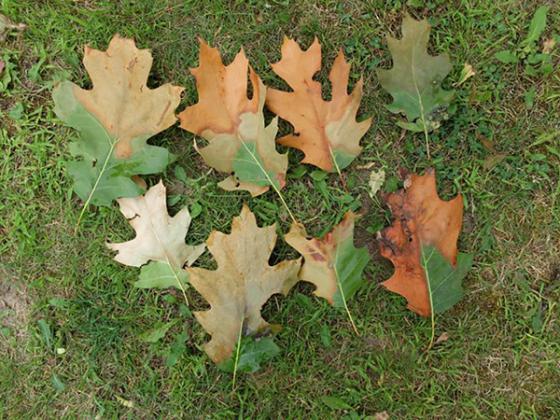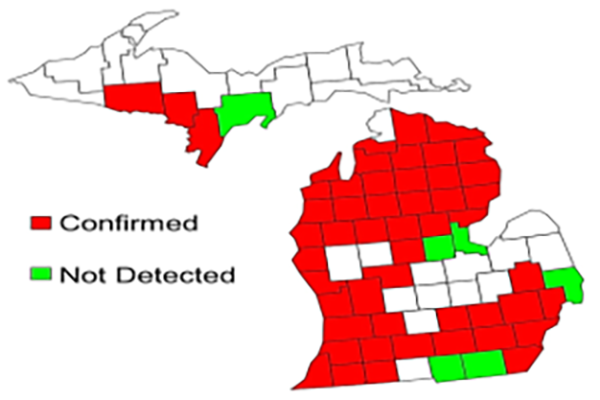Oak leaves showing oak wilt symptoms: Browning or bronzing of leaf tips and margins while the lower part of the leaf remains green (indicates oak wilt is present but requires a lab diagnosis to confirm).
Diagnostic results of samples submitted to MSU Plant & Pest Diagnostics from Jan. 1, 2015, to Dec. 21, 2020, showing the widespread distribution of oak wilt. Figure courtesy of Center for Environmental and Regulatory Information Systems (CERIS), Purdue University. “NPDN data for Oak Wilt - Bretziella fagacearum”.
By Vicki Browne
Four years ago Chris West, the long-time manager of Pentoga Park, noticed that one of the large oak trees in the parking lot near the beach dropped all its leaves within three days midsummer. The tree didn’t come back the following spring, but whatever killed it had traveled to the adjacent tree.
The oaks in the parking lot had a fungal disease commonly called ‘oak wilt’. Three of the four trees had to be cut down and the stumps pulled out.
“So far, so good for that last, great big oak,” said West.
Oak wilt comes from fungal spores, bretziella fagacearum, that kill oak trees. Oak wilt is well established in 61 counties in Michigan. Three counties bordering Wisconsin in the U.P. have it –Iron, Dickinson and Menominee. According to West, oak wilt has killed trees at Bewabic State Park, at Glidden Lake and various locations along County Road 424.
Brock VanOss, owner of VanOss Forestry Services LLC and 2023 Stewardship Forester awardee, confirmed that oak wilt started killing oaks at Lake Antoine Park, near Iron Mountain, about 20 years ago.
Oak wilt was first identified in 1944, became established in lower Michigan in the 1950’s and began rapidly spreading in the 1980’s.
Trees in the red oak family (red, black and pin), the ones with pointy-tipped leaves, are most susceptible and die very quickly. Huge, old trees can be killed within three - six weeks.
Trees in the white oak family (white and bur), the ones with round-tipped leaves, are less susceptible, but can still be symptomless carriers.
The bretziella fagacearum spores enter an oak tree where it has a wound and plug up the xylem cells that allow the tree to transport water. The leaves, starting at the top, begin to wilt. They turn partially brown or bronze and fall off. Once a tree is infected, it cannot be saved.
In Pentoga Park’s campground West discovered two more trees that seemed to have oak wilt. This invasive disease had spread from the parking lot to the more vulnerable campground.
“The original section of the park, including the burial grounds, are all oaks,” said West. “It’s a good thing the section near (County Road) 424 is mostly maples.”
When VanOss assessed the situation, his prognosis was grim.
“Take a good look at the park now,” said VanOss. “It’s not going to look like this in a few years and that’s a shame.”
The campground’s oaks are more vulnerable because the most successful strategy for saving healthy oaks, trenching, cannot be done where there are buried water and power lines.
Trenching involves identifying infected trees and then using a vibratory plow to sever tree roots that are connected underground. The recommendation is to identify the epicenter of the infected trees and then trench around the outside of the seemingly healthy oak trees that surround the sick ones. This is because trees of the same species graft their roots underground in order to share water, carbon and nutrients. Disease can also flow from tree to tree through these grafted roots.
The other way oak wilt spreads is by spores carried by bark beetles and picnic beetles. Once an oak dies, it becomes a dangerous tree. Spore mats, also called pressure pads, push bark away from the dead red oak’s trunk. The spore mats have a fruity aroma that attracts the beetles. The beetles get spores on their bodies and transport it to wounded areas of healthy trees.
“In the park all we can do if a tree sheds all its leaves is take it down and pull up the stump with a backhoe,” said West.
West is right. A tree infected with oak wilt must be removed as quickly as possible. The recommendation is to take out healthy trees adjacent to the infected tree as well to save the rest of a large stand of red oaks.
Once an infected tree is removed, the recommendation is to burn it or turn it into lumber immediately. If this cannot be done, then securely tarp the logs so that beetles cannot get to the spore mats. Spore mats can survive for several years on drying logs.
“It takes two - three years for oak to dry if you don’t split it,” said West. “We’d have one heck of a bonfire if we burned those huge oak trees.”
There are other reasons why an oak would shed its leaves or have brown and green patches on them.
“If you suspect oak wilt, have a forester inspect the trees and send appropriate samples down state to be tested,” said VanOss.
VanOss suggested several proactive strategies for slowing the spread of oak wilt. Other recommendations came from the Michigan State University Extension’s oak wilt archives.
• Never prune live oak trees between April 15 and July 15.
• Do not transport firewood. The safe bet is to buy and burn on site.
• Put off construction projects around oak trees until late summer.
• Be careful using a lawn mower or weed wacker around oak trees.
• Tour your property after storms or high wind days to look for damaged oak trees.
• If an oak gets damaged or a limb falls off, paint the wound with pruning sealer or latex paint. Paint the wound quickly because beetles which might be carrying oak wilt spores can find fresh wounds within a ½ hour.
• Always consult a forester when planning to manage your woods or forest. “A healthy forest is able to fight better,” according to VanOss.
To read more about oak wilt, visit the MSU Extension College of Agriculture and Natural Resources, search for ‘oak wilt’: www.canr.msu.edu/
Contact the Iron Baraga Conservation District to talk to a forester about forestry management or suspected oak wilt: 906-875-3765



